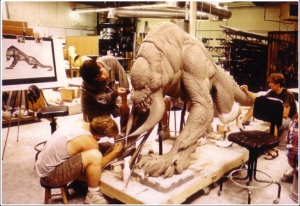Relic seems like such a classic kind of story, it should be done more often. You get a touch of Indiana Jones, mixed with Theseus and the Minotaur, to equal Night at the Museum. With body parts. Sounds good to me! ( Oh and there are SPOILERS!)
I love stories having to do with mysterious cultures and their monsters/gods. Relic’s monster comes from a thought-to-be extinct tribe in the Amazon, a curse centered around an old idol discovered and shipped to the New York Museum of Natural History. The monster comes along with it, a beast that could be ape-like, lizard-like, or big cat-like (the book including the cover hints at something like a pissed-off gorilla with raptor claws, while the movie has this apey-lizardy thing that looks badass). It makes its home in the labyrinthine tunnels under the museum, stalking its prey. This giant scary ape-lizard hunts you, rips you apart and then noses around in your brain to eat this tiny little delicate part that is almost like a drug to it. It’s like a chocoholic with preternatural strength going nuts in a Godiva store and ripping everything apart just to get to the cherry cheesecake truffles, because they’re addicted to them. Only there’s not as much human carnage.
The book never gives a great description of the monster itself, almost pulling a movie trick of keeping the beast in the shadows. Even when Margo finally confronts it in the end she doesn’t get a good look at it. I really enjoyed the way the monster looked in the movie (though the movie itself isn’t all the great). It looks truly horrifying, and can definitely rip you in half without batting an eye. The fact that there is almost human intelligence behind all that power and hunger, and you can see why everyone in the museum would be terrified. All of the science behind the monster’s creation lost me a little bit though. It has to do with these specific plants that grew in the area where the tribe was from, and the enzymes from the plant were like a virus that mutated the tissue, or something crazy like that. And that enzyme was similar to the hormone secreted by the hypothalamus that the monster needs to nosh on in order to survive. Basically, the plants mutate animal tissue. Or human tissue. In the book, none of the brilliant scientists ever figure that out, except for one guy that of course wants to use it (enter Book Two). I liked in the movie at least they figure out at the end that the monster used to actually be a person.
The setting itself is great too: a huge, old museum, built on top of an even older structure full of twisty tunnels is the perfect setting for a more modern monster story. It reminds me of the old monster story of the Minotaur, roaming around his maze, stalking his meals while they haphazardly wander around getting more lost by the minute. The monster is obviously not lost. It’s not until Pendergrast produces blueprints that the monster loses some of its power.
All in all I enjoyed Relic. While I am not rushing out to read Reliquary, I think the book stands on its own as a different take of the monster in the maze story, with an actually unique monster in the middle.
6 Comments
Comments RSS TrackBack Identifier URI



The science was a little wacky, but I went with it for the most part, except right when they discovered the secret of the plants. That confused me. I’m still a little confused about how the whole thing came about.
The one thing about the science that I was just like “WHAA” about was to wonder how the creature knew that if it couldn’t get its plants, brain parts were a good substitute. Was it instinctual?
I think that had something to do with his heightened sense of smell. Given how strong it was, it could probably smell that some part of the human brain carried an odor similar to the plants.
I like the idea of Mbwun as the minotaur. The parallel hadn’t occurred to me, but it seems obvious now.
Definitely agree that the minotaur is a great parallel, especially when they are stuck down in the subbasement and the entire museum is on lockdown. Also, the fact that it had near human intelligence was probably scarier than any other aspect.
When I pictured the monster, I didn’t end up getting something even quadrupedal until the second half of the book. I saw it like a lizard man at first. A troglodyte (like the dnd one) to be exact. Probably because the the horrible stench everyone mentioned. The trog has a stench ability. Yes. I’m a nerd.